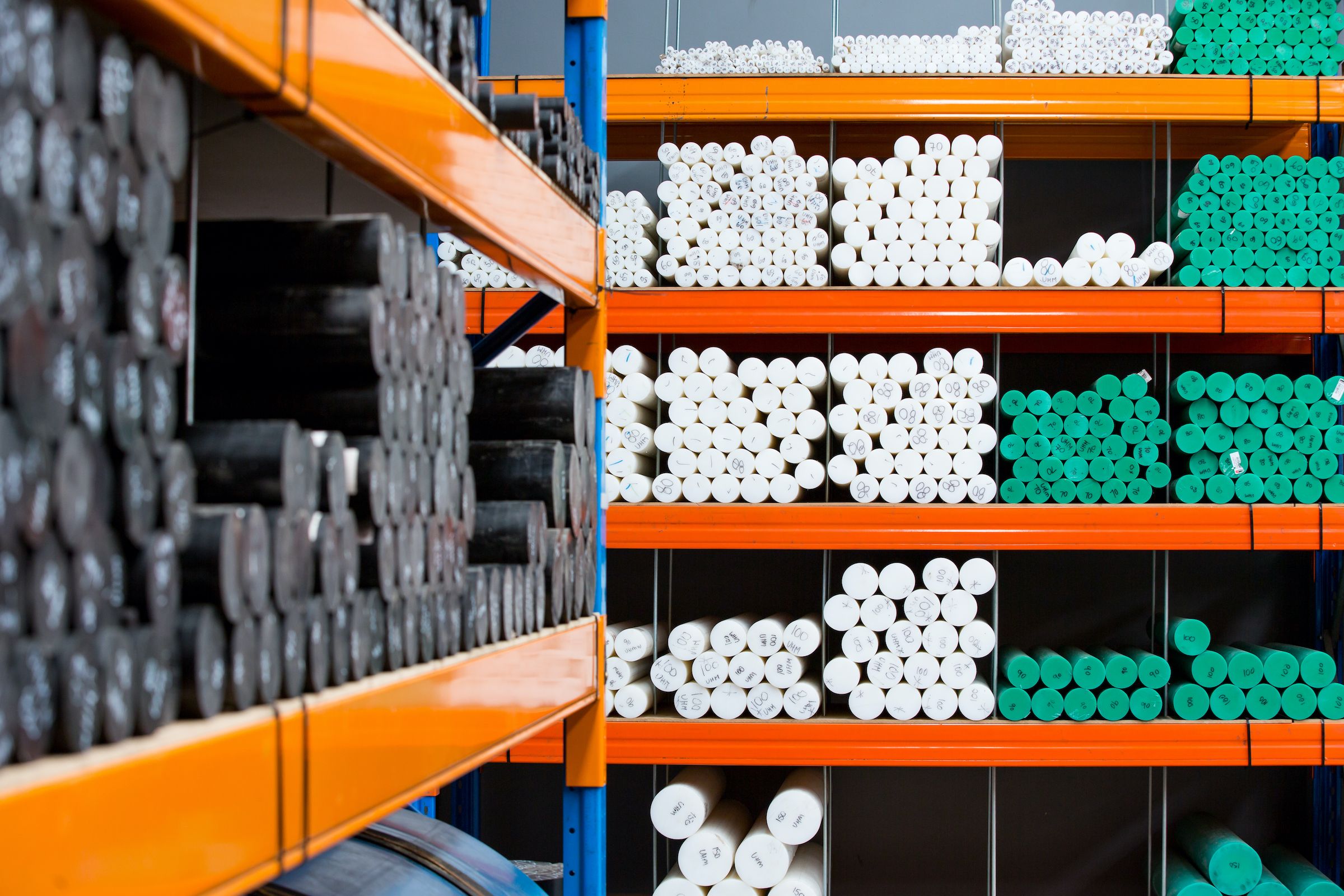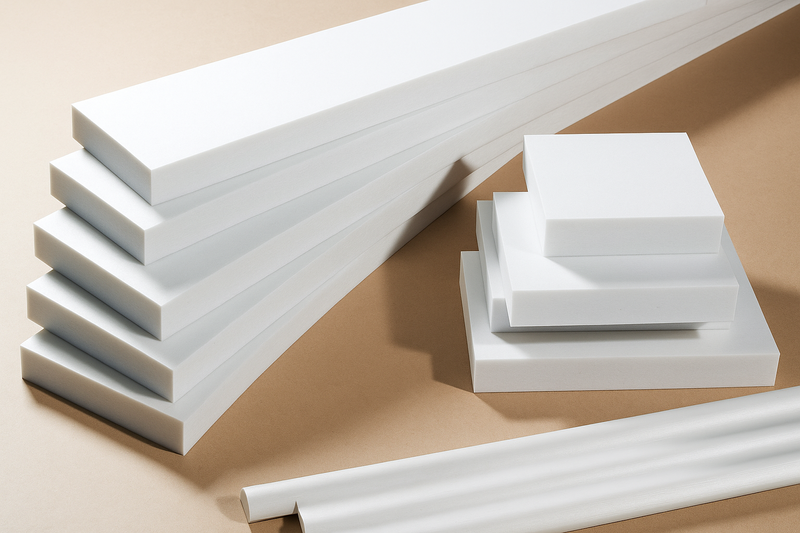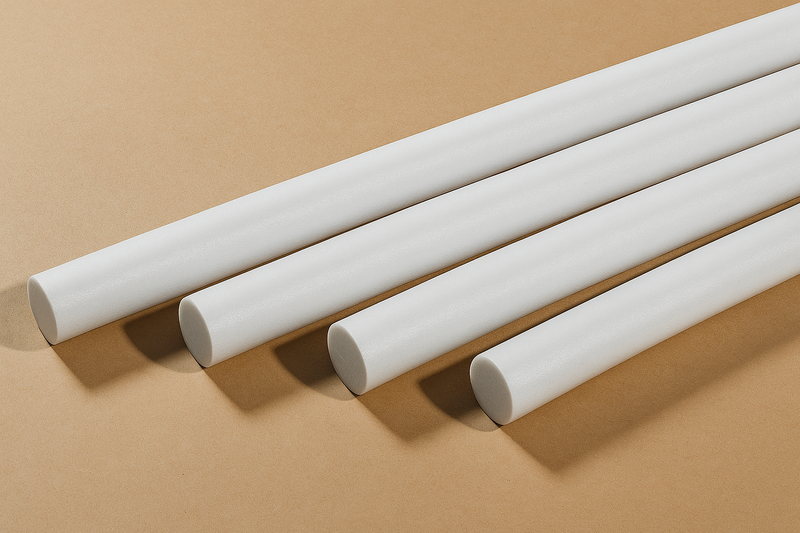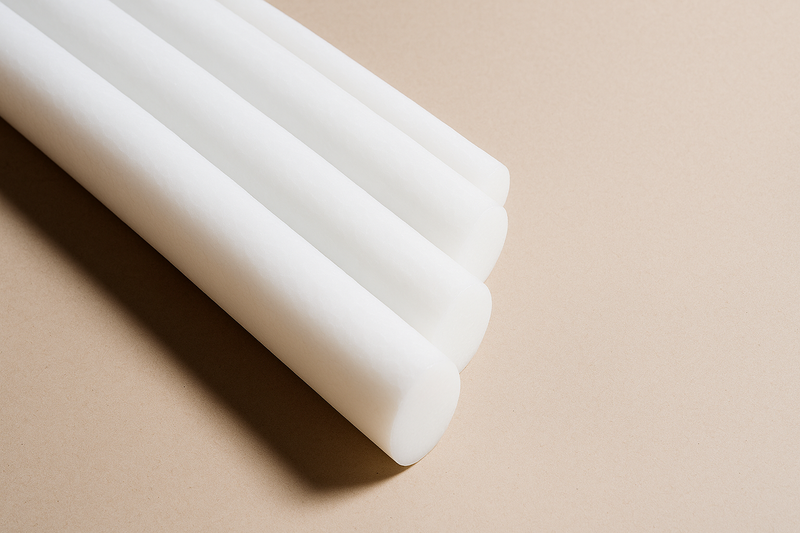At a glance
- HDPE offers a strong balance of tensile strength, chemical resistance, and low friction, ideal for lightweight, cost-effective industrial components.
- Other plastics, such as POM, Nylon, UHMWPE, PET, PTFE, and PEEK, are designed for precision stability, heavy-load capacity, abrasion resistance, or extreme chemical and temperature tolerance.
- Choose materials based on your application’s priorities, balancing durability, chemical compatibility, temperature tolerance, wear resistance, and cost.
High-Density Polyethylene (HDPE) is a versatile thermoplastic polymer valued for its lightweight strength, low friction, and excellent chemical resistance. These properties make it a reliable material for a wide range of industrial and commercial applications.
However, HDPE isn’t the only engineering plastic available. Each material has its own strengths and limitations, which affect factors like durability, wear resistance, temperature tolerance, chemical compatibility, and cost. Understanding how HDPE compares to other options is essential to ensure you choose the right material for your specific application.
This guide details the difference between HDPE and popular engineering plastics, including POM, Cast Nylon, UHMWPE, PET, PTFE, and PEEK, to help you select the best material for your project.
HDPE vs Other Engineering Plastics
Selecting the appropriate plastic depends on operational requirements such as mechanical load, chemical exposure, temperature, wear, and recyclability.
Below is a comparison of HDPE with commonly used engineering plastics.
Durability & Strength
HDPE has a tensile strength of approximately 38 MPa (megapascals) and a favourable strength-to-density ratio due to its linear polymer structure. While it provides good durability for general-purpose use, it is less stiff and not as load-bearing as some higher-grade engineering plastics.
Cast Nylon significantly outperforms HDPE in mechanical strength, with a tensile strength of around 82 MPa. This makes it far more suitable for heavy-duty gears, rollers, and bushings that require both strength and impact absorption.
UHMWPE does not match HDPE in terms of tensile strength, averaging around 17-19 MPa. However, it surpasses nearly all other plastics in impact resistance. In standard notched impact tests, UHMWPE often doesn’t break, highlighting its exceptional toughness for demanding, high-impact applications.
PET plastic offers higher tensile strength than HDPE, typically between 55–75 MPa, but is more brittle. While it is stronger under tension, it is less resilient to sudden impacts, meaning HDPE may be a better choice in impact-heavy use cases.
PEEK sits at the premium end, with tensile strength in the 90–100 MPa range, more than double that of HDPE. It delivers exceptional load-bearing performance, making it ideal for high-precision, high-stress engineering applications.
PTFE is considerably weaker in terms of structural strength, with a tensile strength typically in the 20–25 MPa range. It deforms easily under mechanical stress, so HDPE is the better option for load-bearing uses.
Note: The tensile strengths above refer to standard grades used in typical industrial and commercial applications. Performance can be increased through reinforcing materials, optimising molecular weight and crystallinity, or other specialised processing techniques.
Chemical Resistance
HDPE has excellent chemical resistance, performing well in the presence of most acids, alkalis, and solvents. It is ideal for applications such as tanks, piping, and chemical processing equipment.
POM (Acetal) offers good chemical resistance, though it is slightly less effective than HDPE when exposed to strong alkalis. In applications involving aggressive base chemicals, HDPE has the advantage.
Cast Nylon is more vulnerable than HDPE in chemical environments due to moisture absorption and susceptibility to acids. HDPE consistently outperforms Cast Nylon in long-term chemical exposure scenarios.
UHMWPE matches HDPE’s chemical resistance almost exactly, offering the same level of protection against concentrated acids, alkalis, and solvents. In chemical handling applications, either material is suitable.
PET has weaker chemical resistance than HDPE, particularly against strong alkalis. This makes HDPE the preferred choice for alkaline cleaning processes or corrosive industrial settings.
PTFE surpasses HDPE in chemical inertness, resisting virtually all chemicals even under extreme conditions. PTFE plastic is ideal for environments with highly aggressive chemicals where other plastics may fail.
PEEK also outperforms HDPE in aggressive chemical environments, maintaining stability in strong solvents, fuels, and high-purity applications where HDPE might degrade over time.
Temperature Range
HDPE can operate continuously from -40°C to about 80°C, with short-term peaks up to 120°C. At higher sustained temperatures, it will soften and lose mechanical stability.
Acetal plastic can be used continuously up to around 100°C, offering better high-temperature resistance than HDPE. For applications above 80°C, POM maintains its integrity longer, making it more suitable for warm operating environments.
Cast Nylon outperforms HDPE in heat tolerance, withstanding continuous service up to 120°C. This makes it better for high-friction, heat-generating applications.
UHMWPE has a slightly higher continuous temperature limit than HDPE, up to around 90°C, but its primary advantage remains impact resistance rather than thermal performance.
PET has a lower temperature capability than HDPE, around 70°C, so HDPE is preferred for applications involving moderately elevated temperatures.
PTFE has a much wider range than HDPE, from –200°C to 260°C, and retains properties across this spectrum. For extreme temperature variation, PTFE is the superior option.
PEEK plastic rivals PTFE in high-temperature resistance, operating up to 260°C with a melting point of 343°C, exceeding HDPE’s thermal limits and making it ideal for demanding high-heat applications. As a result, PEEK has versatile applications across a spectrum of industries.
Wear and Friction
HDPE has a naturally low coefficient of friction, making it effective for general sliding applications, liners, and wear strips.
POM (Acetal) offers comparable low friction with added dimensional stability, making it ideal for precision gears, bearings, and rollers.
Cast Nylon has slightly higher friction than HDPE but offers excellent abrasion resistance, providing durability in demanding, high-wear environments like construction. Cast Nylon has made considerable contributions to the construction sector.
UHMWPE stands out in this category, offering extremely low friction and exceptional abrasion resistance. It often matches or even exceeds PTFE’s sliding performance while providing superior impact resistance.
PET has moderate frictional performance and generally underperforms compared to HDPE or UHMWPE in self-lubricating applications.
PTFE remains the gold standard for ultra-low friction, making it the preferred choice in sealing, non-stick, and anti-galling applications.
PEEK provides a balanced combination of wear resistance and mechanical strength, enabling reliable performance in high-load, high-speed bearing and bushing applications.
Brief Comparison of HDPE vs Other Engineering Plastics
To assist in quick decision-making, the following table summarises the key performance metrics for HDPE and other engineering plastics discussed above. It provides a side-by-side view of tensile strength, chemical resistance, temperature range, and wear performance to help users evaluate materials at a glance.
|
Plastic |
Strength and Durability |
Chemical Resistance |
Temperature Range |
Wear & Friction |
|
HDPE |
38 MPa |
Excellent |
–50°C to 80°C |
Low |
|
POM |
62 MPa |
Similar to HDPE |
Higher (~100°C) |
Low, better for precision |
|
Cast Nylon |
82 MPa |
Moderate, moisture-sensitive |
Higher (~120°C) |
Moderate friction, high abrasion |
|
UHMWPE |
17-19 MPa |
Excellent |
Slightly higher (~90°C) |
Very low, ideal sliding |
|
PET |
55-75 MPa |
Moderate, sensitive to alkalis |
Moderate (~70°C) |
Moderate |
|
PTFE |
20-25 MPa |
Exceptional and resistant to nearly all chemicals |
Very wide (-200 to 260°C) |
Extremely low |
|
PEEK |
90-100 MPa |
Excellent |
Very High (260°C) |
Low to moderate friction with excellent wear resistance |
The bottom line is that HDPE remains one of the most versatile and cost-effective engineering plastics, offering a balance of strength, chemical resistance, low friction, and ease of processing. While it is not the highest performer in every category, its combination of properties and affordability makes it a go-to material for many general-purpose uses.
The comparison against Acetal, Cast Nylon, UHMWPE, PET, PTFE, and PEEK highlights that material selection should always be driven by specific application needs.
- Acetal is ideal for precision parts requiring dimensional stability.
- Cast Nylon excels under heavy mechanical loads.
- UHMWPE dominates in abrasion and impact resistance.
- PTFE offers unmatched chemical and thermal resistance.
- PEEK provides exceptional high-performance strength and temperature tolerance.
Ultimately, choosing between HDPE and other engineering plastics depends on balancing performance, durability, and cost for your project’s unique requirements.
Not sure which engineering plastic is right for your project? Visit ePOL’s online portal for detailed information about each material so you can understand which option best fits your needs. For expert guidance on complex or specialised projects, contact our team to ensure you select the right material for optimal results.
FAQs
Can HDPE be reinforced to improve its strength and temperature resistance?
Yes, HDPE can be reinforced with fillers such as glass fibre or minerals to enhance stiffness, tensile strength, and temperature tolerance. However, reinforced grades may sacrifice some of HDPE’s natural impact resistance and chemical inertness.
How does HDPE perform in outdoor or UV-exposed environments compared to other plastics?
Standard HDPE is susceptible to surface degradation and embrittlement when exposed to prolonged UV radiation. For outdoor applications, UV-stabilised grades with added carbon black or UV inhibitors are recommended. Compared to materials like PTFE or certain UV-stabilised polyesters, unmodified HDPE has lower UV resistance, but treated grades perform competitively in long-term outdoor use.
Is HDPE recyclable, and how does this compare to other engineering plastics?
HDPE is one of the most widely recycled plastics, identified by resin code “2.” Its recyclability rate is generally higher than that of other specialised engineering plastics like PEEK, PTFE, or Cast Nylon. Recycled HDPE can be reprocessed into piping, plastic lumber, containers, and non-critical structural components.
Can HDPE be used in food-grade or sanitary applications?
Yes. Virgin, food-grade HDPE meets FDA and EU food contact regulations, making it suitable for cutting boards, food processing equipment, and sanitary piping.








